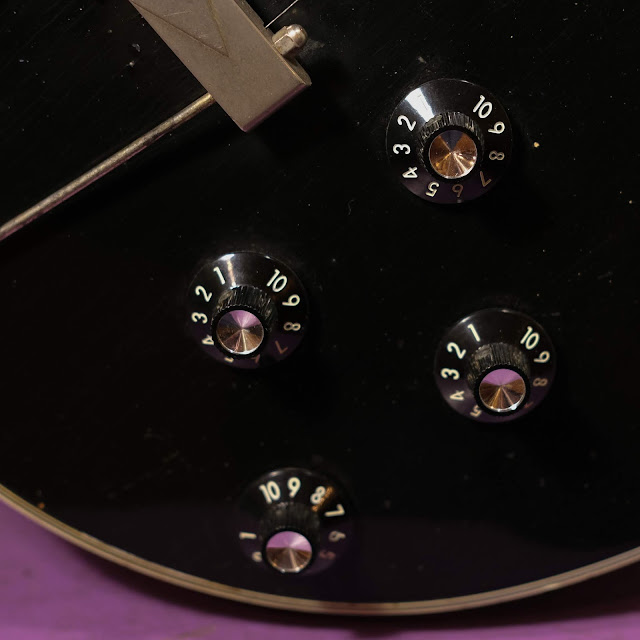1960s Harmony-made Silvertone 1446 (Modified) Hollowbody Electric Guitar
Third time's the charm, right? I originally worked on two "cobbled-together" Harmony guitars using Rocket-style bodies and parts, but since then the owner of one of them changed his mind about the build's direction and so the original neck for this guitar came back to me. Now it's reunited with its body and this almost-a-1446 is the result.
The neck, tuners, truss cover, body, bridge pickup, neck pickup surround, and 3-way switch plate are all period '60s Harmony parts. The wiring harness, neck pickup, bridge, and tailpiece are not. I used a '65 DeArmond goldfoil pickup at the bridge and a new goldfoil mini-humbucker (Firebird-style) at the neck. These make a really, really great pair as they have about the same oomph and blend nicely. It's not like going from super-thick at the neck to thin and biting at the bridge -- both are clean, clear, kerrangy-sounding, and love to kick an amp into drive. That sort of radial airplane engine or buzzsaw sound is exactly what they do best.
So, yeah, it's a rock-machine. I find the necks on these guitars a little quirky if you're not used to them as they don't widen-out as you get to the body (as on most Harm electrics), but the medium/big shoulders C profile and steep 10" radius to the board means they have a deceptive amount of space to place your fingers. I love sliding chords up and down them but I need to be a little more accurate than average when I'm playing lead. The short scale length makes you feel like a hero, however, as the tension is lower.
Repairs included: a fret level/dress, new wiring harness with 500k pots, Mallory caps, and Switchcraft 3-way and jack -- the good stuff, cleaning, replacement (period) Kluson tailpiece and Japanese-made Bigsby-style bridge, replacement knobs, and a good setup.
Setup notes: action is bang-on at 1/16" at the 12th fret overall. Strings are 46w-10 with a wound G. The truss rod works and the neck is straight. Frets are the normal low-ish medium stock found on period Harmony guits. The bridge is compensated for a wound G-string which is actually an advantage because the short scale means that a plain-G setup can't be played as hard or the G will bend all over the place. I have an 18w string on there at the moment.
Scale length: 24 3/16"
Nut width: 1 3/4"
String spacing at nut: 1 1/2"
String spacing at bridge: 1 7/8"
Body length: 19 1/2"
Lower bout width: 15 5/8"
Waist width: 9 1/2"
Upper bout width: 11 1/4"
Side depth at endpin: 1 7/8"
Body wood: ply birch?
Neck wood: ply birch?
Fretboard: ebonized maple
Bridge: adjustable Bigsby-style aluminum bridge
Neck feel: medium C-shape, 10" board radius
Condition notes: well, first of all, it's a "cobbler special." It's mostly a Silvertone 1446 and the body, neck, neck pickup surround, and 3-way switchplate are original to the guitar. The rest is not, though many of the parts are vintage and fit with the vibe. There's finish weather-checking throughout the instrument and there's a lot of rub/wear to both the back of the neck (where the primer gray shows through in spots) and to the waist-back.
Also: someone cut a small hole in the back of the body, too, and there's a metal patch over it. There are a few filled-in tiny screwholes on the top near the pickup surrounds, too, but they're not obvious. There's a tiny dinged/damaged area of binding on the bass side of the neck and there's plenty of minor wear to the fretboard, but it does not distract from playability. There are a couple hairline cracks near the jack on the side but they were glued-up in the past and are a non-issue.
























Comments